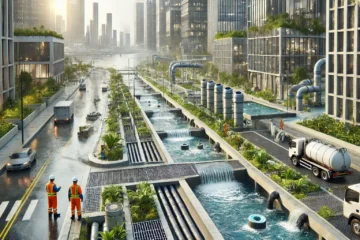Hydropower energy, one of the oldest forms of renewable energy, harnesses the power of flowing water to generate electricity. It involves capturing the kinetic energy of moving water and converting it into mechanical energy, which is then used to drive generators.
How Hydropower Works:
- Water Storage: Water is stored in a reservoir, often created by a dam.
- Water Release: Controlled amounts of water are released from the reservoir.
- Turbine Power: The flowing water spins turbines, converting kinetic energy into mechanical energy.
- Electricity Generation: The mechanical energy from the turbines is used to drive generators, producing electricity.
Types of Hydropower Plants:
- Impoundment Hydropower: This type involves storing water in a reservoir created by a dam. The water is released to generate electricity as needed.
- Run-of-River Hydropower: This type uses the natural flow of a river to generate electricity. It requires a smaller dam or weir to divert water into a turbine.
- Pumped Storage Hydropower: This type stores excess energy by pumping water uphill to a reservoir. When electricity is needed, the water is released to generate power.
Advantages of Hydropower:
- Clean and Renewable: Hydropower produces electricity without emitting greenhouse gases.
- Reliable: Hydropower plants can generate electricity consistently, regardless of weather conditions.
- Flexible Operation: Hydropower plants can quickly adjust their output to meet changing electricity demands.
- Multiple Benefits: Hydropower plants can provide additional benefits, such as flood control, irrigation, and recreation.
Environmental Considerations:
While hydropower is a clean energy source, it can have environmental impacts, such as:
Greenhouse Gas Emissions: In some cases, the construction and operation of hydropower plants can release greenhouse gases.
Habitat Disruption: Dam construction can disrupt aquatic ecosystems and affect fish migration.
Sedimentation: Reservoirs can trap sediment, reducing water quality and affecting downstream ecosystems.
Economic and Social Benefits of Hydropower
Hydropower, a renewable energy source harnessing the power of flowing water, offers numerous economic and social benefits:
Economic Benefits
- Low Operating Costs: Hydropower plants have minimal operating costs, as they rely on a renewable resource (water) and require minimal fuel. This leads to lower electricity prices for consumers.
- Job Creation: The construction and operation of hydropower plants create jobs in various sectors, including engineering, construction, and maintenance.
- Economic Development: Hydropower projects can stimulate economic growth in rural areas, leading to increased investment and development.
- Foreign Exchange Earnings: Hydropower plants can generate significant revenue through the export of electricity.
- Reduced Fuel Costs: By reducing reliance on fossil fuels, hydropower can help lower fuel costs for industries and households.
Social Benefits
Community Development: Hydropower projects can contribute to community development by providing infrastructure, healthcare, and education facilities.
Reliable Power Supply: Hydropower plants can provide a stable and reliable source of electricity, especially during peak demand periods.
Flood Control: Dams associated with hydropower plants can help regulate water flow and reduce the risk of floods.
Water Supply: Reservoirs created by dams can provide water for irrigation and drinking water supply.
Recreational Opportunities: Hydropower reservoirs can offer recreational opportunities like boating, fishing, and swimming.
It’s important to note that while hydropower offers significant benefits, it’s crucial to balance these with potential environmental impacts. Careful planning and implementation of environmental safeguards are essential to ensure sustainable hydropower development.
Environmental Impact of Hydropower: A Closer Look
While hydropower is often considered a clean and renewable energy source, it’s essential to acknowledge its potential environmental impacts.
Key Environmental Concerns:
- Habitat Disruption:
- Dam construction can fragment rivers and disrupt fish migration patterns.
- The creation of reservoirs can flood large areas of land, destroying habitats and displacing communities.
- Sedimentation:
- Sedimentation in reservoirs can reduce their storage capacity and impact water quality.
- This can lead to decreased power generation and negative effects on downstream ecosystems.
- Greenhouse Gas Emissions:
- The construction and operation of hydropower plants can release greenhouse gases, particularly during the initial construction phase and from the decomposition of organic matter in reservoirs.
Mitigating Environmental Impacts:
To minimize these negative impacts, several measures can be taken:
Sustainable Reservoir Operations: Optimizing reservoir operations to minimize environmental impacts.
Fish Passage: Implementing fish ladders and other techniques to allow fish to migrate upstream and downstream.
Sediment Management: Implementing sediment management strategies to reduce sedimentation in reservoirs.
Ecosystem Restoration: Restoring damaged ecosystems and creating new habitats.
By carefully considering these environmental factors and implementing appropriate mitigation measures, hydropower can continue to be a valuable source of clean energy.
Despite these challenges, hydropower remains a valuable source of renewable energy. Continued advancements in technology and sustainable practices can help mitigate environmental impacts and maximize the benefits of hydropower. By optimizing existing hydropower plants and exploring new opportunities, we can harness the power of water to create a more sustainable future.


